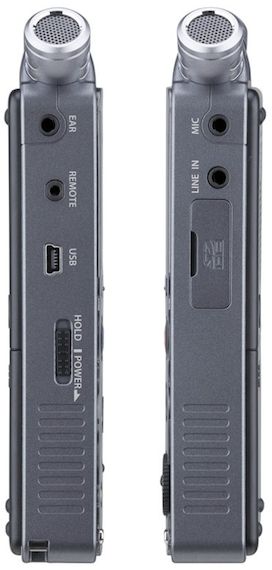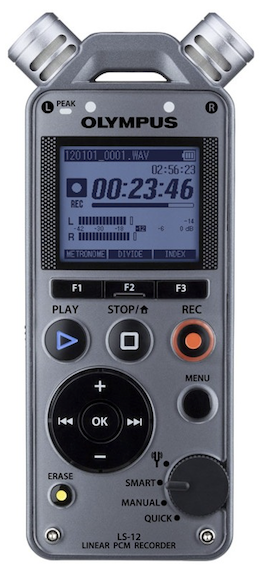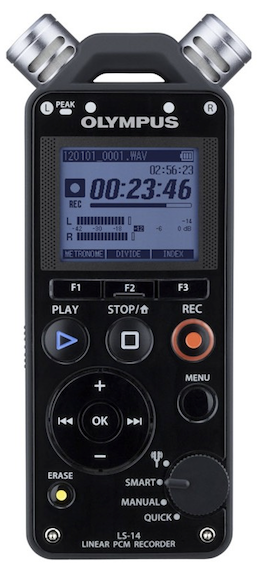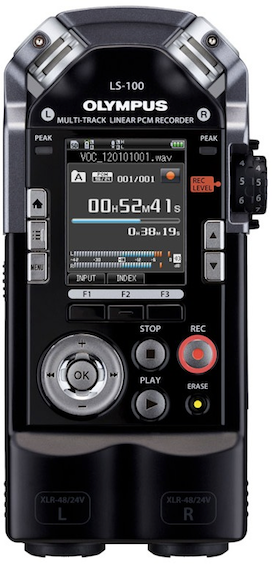OLYMPUS PORTABLE RECORDERS - LS-12, LS-14 & LS-100
Posted on Wed 05 June 2013 in entries
 So, you're on the market for a portable recorder for music purposes. One brand that you're likely to see popping up time and time again in your searches is Olympus... and for good reason! Olympus make some excellent compact recording options for people with a variety of needs and budgets and in this article I'm going to take a look at three of their most popular handheld gadgets: the LS-12, LS-14 and LS-100, all of which are specifically designed for musicians...
So, you're on the market for a portable recorder for music purposes. One brand that you're likely to see popping up time and time again in your searches is Olympus... and for good reason! Olympus make some excellent compact recording options for people with a variety of needs and budgets and in this article I'm going to take a look at three of their most popular handheld gadgets: the LS-12, LS-14 and LS-100, all of which are specifically designed for musicians...
The Olympus LS-12 is a compact, budget friendly stereo recorder, which is great for using on-the-move. Capable of recording sounds up to 24-bit/96kHz (bear in mind that this far outstrips the 16-bit/44.1kHz quality of CDs), the LS-12 is a fantastic device for capturing detailed audio, however you intend to use it. Maybe you're recording samples on location for use in a song/soundtrack and so are demanding high-quality, detailed sound-capture. Or perhaps you're wanting a way to record practice-sessions, gigs or ideas. You may even just simply want something to capture speech from a lecture or presentation. For any of these situations, the high-quality microphones of the LS-12 will serve you well and the fact that this recorder can capture sound up to 130dB without distorting means that it's a more than capable tool for most situations, including recording loud live-acts.
The Olympus LS-12 is designed with a pair of on-board 90-degree directional microphones, meaning that it can record a stereo sound (e.g. one that differs in the right and left channel). As these microphones are of condenser type, they are excellent at picking up fine details and nuances and can capture sounds between 60Hz and 20Hz. Consider that the range of human hearing is generally stated as 20Hz-20kHz and you'll realise that there isn't much that the LS-12 misses out on; it's just a small section of those lower bass frequencies that are outside of its capabilites to record. That's not to say that it can't capture bass frequencies though - if you've ever heard a 60Hz signal before then you will be well aware that this is still low!
One really cool feature of the LS-12 is its switchable microphone sensitivity. By selecting whether you would like the microphones to perform in 'High', 'Medium' or 'Low' sensitivity mode, you can actually adjust their performance to match each different recording scenario. At 'Low' settings, the LS-12 recorder will only pick up very loud sounds, or sounds that emanate from very close to the microphone capsules. At 'Medium' settings, the mics become a little more sensitive and on the 'High' setting, the LS-12 will pick up more ambient sounds. Therefore, if you just want to capture a general atmosphere, you will probably favour the 'High' setting, whereas if you want to focus the recording on a particular sound (e.g. a voice), you'll be best suited with the 'Low' mode. It may however be worth experimenting with each setting in important recording situations to see which gives the best results.
In terms of internal design, the Olympus LS-12 has also been well thought-out. It separates the audio and system circuitry to ensure that noise/interference is kept to a minimum, which keeps your recordings as clean as possible. The LS-12 also features a switchable high-pass filter with 100Hz and 300Hz options, which eliminate all frequencies below the cut-off from the recording. This is extremely useful for reducing background noise and even for coping with other unwanted artifacts that would be undesirable.
Another highly-praised feature of the Olympus LS-12 is its ease of use. It features a 1 3/4 inch LCD screen, which feeds back important information such as levels, recording time, record status, file names, battery level, etc., whilst also allowing you to browse your library of audio tracks. There are also three Function buttons immediately beneath the screen, which correspond to virtual labels on the LCD above. This means that the LS-12 can remain uncluttered and intuitive, as with relatively few controls it can perform a large range of tasks. If you think this therefore means that the LS-12 requires you to delve through endless menus to use it then you would be most mistaken though; everything is very straight-forward and quick to access.
Of course, the LS-12 features individual buttons for all the most common features of a recording device (e.g. Play, Stop, Record, etc.) but another great user-friendly feature is the Mode Select Dial, which allows you to quickly select you current working mode, with a choice of 'Tuner', 'Manual' and 'Smart'.
Tuner mode allows you to use the LS-12 as a chromatic tuner for musical instruments, demonstrating another string to this little gadget's bow. Manual mode is designed for experienced users or for anyone that requires fine control over their recordings, allowing you to set your own levels and adjust them during recording. Finally there's the Smart mode (which I imagine will be the most common mode of operation for most users). This mode is ideal for anyone new to recording or who just wants to quickly capture high-quality sound without having to faff around with settings.
In Smart mode, the LS-12 automatically detects the optimum recording level and adjusts accordingly when you hit 'Record'. Simply present it with the loudest sound that you will be recording (whether that be a raised voice, a heavy percussive hit or the peak of a crescendo moment in a performance, etc.) and the LS-12 will do the rest!
As with all the portable recorders we are focusing on in this article, the Olympus LS-12 has been designed with musicians in mind and so comes with a number of additional features that you're likely to find very useful. First up, the LS-12 allows for overdubbing. This means that you can layer additional sounds over an existing recording to build up whole songs and more complex ideas. There are also a number of other useful recording features such as the pre-record buffer, which captures a few seconds of audio before you actually press 'Play' (just so that you never accidentally miss the start of something important or can react to record an unexpected sound) as well as a host of useful file management and editing options (e.g. File Divide and Partial Erase).
 ](https://www.absolutemusic.co.uk/olympus-ls-12-portable-digital-recorder.html)
](https://www.absolutemusic.co.uk/olympus-ls-12-portable-digital-recorder.html)
The Olympus LS-12 also allows you to control the playback speed of your audio files without changing the tone. You can speed them up and slow them down (max 300%, min 50%), which can be used both creatively and for practice purposes. For example, you may be a musician who is wanting to play along with a song that is currently beyond your skill level at full speed. In this case, simply use the adjustable playback speed function of the LS-12 to slow it down to a more comfortable speed and then you can gradually pick up the tempo as your skills improve.
As we're on the subject of musicians' tools, we may as well also give mention to the built-in metronome that comes with the LS-12. Essentially, the LS-12 is a mini-toolbox for musicians!
The Olympus LS-12 can capture audio in both mp3 or PCM formats, which caters for various needs. For example, if you are recording ideas or practice sessions, mp3 might be your preferred capture format as sound files will take up less memory, allowing you to record more. However, if your mission is to take in high-quality samples for use in your music projects, then you're likely to favour PCM recordings, which despite taking up much more room in memory due to their uncompressed nature, will invariably capture minor details in the sound that mp3 discards.
On the subject of memory, you get 2GB of it built-into the Olympus LS-12, although you can purchase optional SD/SDHC memory cards to increase this by up to 32GB more, which is of course useful if you need to record large quantities of audio before you get chance to back-up on your computer.
For the purpose of portability, the Olympus LS-12 operates on two AA alkaline batteries (included in the box) or two AA Ni-MH rechargeable batteries, with an impressive battery life of up to 50 hours! This makes the LS-12 ideal for long location recording sessions.
In terms of connections, the LS-12 features a separate minijack microphone and line-input, plus a headphone socket and a 'Remote' input, which can be connected to an optional Olympus RS30W set (available separately) for remote control over the device's main record functions. There's also a hole on the back for connecting an optional mini-tripod (again available separately), which may be useful if you want to record without holding the LS-12 and are worried about acoustic problems that may be caused by resting it on a hard surface such as a desk (e.g. vibrations from loud noises).
The final connection on the Olympus LS-12 is the USB socket. Using this, you can connect the recorder to your computer using the included USB cable and transfer your files to and from it. This is useful for backing up your work, transferring audio tracks for use in your computer's audio software, or for putting songs on the LS-12 for use with features such as adjustable playback for practice purposes.
I'll finish off by mentioning that the Olympus LS-12's manual (click here to download it) is very well put together, with plenty of step-by-step instructions and diagrams, so even if you're not too confident about recording or technology, you have all the help you need to pick it up as quickly as possible. All in all, the Olympus LS-12 is a fantastic portable recorder for the beginner or for anyone looking for great recording quality on a budget.
If you like the sound of the LS-12 but require some additional accessories, more built-in memory, an improved TRESMIC recording system (more on this in a bit), a Voice Guide and additional editing features, then the LS-14 will be right up your street! In large parts, the LS-14 is the same as the LS-12. It can record sounds up to 24-bit/96kHz with a maximum SPL of 130dB in both PCM and mp3 formats. Again, it runs on two AA batteries (with a slightly reduced maximum battery life of 46 hours compared to the LS-12 due to its more powerful nature), and just like the LS-12, the LS-14 features a fantastic user-friendly design with the same Mode Dial (plus an additional Voice Guide feature with audio announcements if you need it; something that is not featured on the LS-12).
However, I'm sure you have no urge for me to repeat myself on the features that the Olympus LS-14 shares with its slightly cheaper brother, so let's talk about what makes it different! How about starting with the intriguing sounding TRESMIC mic system?
As you may already have guessed, the TRESMIC name refers to the fact that the Olympus LS-14 has three built in microphones (compared to the two of the LS-12). These microphones are made up of the two 90-degree directional condenser mics (as included on the LS-12) along with a third omnidirectional mic placed bang in the centre between them. Due to this design, the TRESMIC system of the LS-14 has an extended frequency response compared to the LS-12. The Olympus LS-14 can in fact pick up frequencies from 20Hz to 20kHz, satisfying the full range of average human hearing, from the highest highs to the lowest lows! Therefore, if you are keen on capturing those real sub-bass frequencies, it's definitely worth forking out those extra few pounds for the LS-14.
The LS-14 features all of the musical and editing features of the LS-12 (e.g. chromatic tuner, metronome, File Divide, etc.), but also adds in a handy trim function. Concealed within its rugged black casing, the LS-14 also doubles the built-in memory of the LS-12, giving 4GB in total and again, this can be expanded with an SD/SDHC card if required.
Finally, the Olympus LS-14 comes with a couple of extra accessories. Included in the LS-14 box along with the two AA batteries and USB cable are a carrying case and clip, which screws into the tripod thread on the bottom of the LS-14 and then allows you to attach the recorder to an accessory such a microphone stand, or simply place it on a flat surface to raise the mics and help prevent surface noise.
So, if you're looking for slightly more detail in your recordings as well as some additional accessories and have a slightly more stretched budget, the Olympus LS-14 is certainly a product that you will want to consider.
The LS-100 represents Olympus' flagship portable music recorder, so if you're after the most feature-packed and best sounding gadget in the LS-range, look no further. Let's start again by looking at the built-in microphones of the LS-100...
The LS-100 features two built-in high-quality 90-degree directional microphones. The design is actually based on the positioning of human ears, which gives great, natural-sounding results. The design also takes into account optimised microphone spacing to help prevent unwanted sonic artifacts caused by sound reflections.
Like both the LS-12 and LS-14, the LS-100 can operate at a maximum quality of 24-bit/96kHz, capturing frequencies with great detail over the entire range of human hearing (20Hz-20kHz) (an improvement over the LS-12's 60Hz minimum range). However, the LS-100 is more capable of capturing louder sounds compared to both the LS-12 and LS-14, as it can record sounds up to 140dB without distortion. Now that's loud and certainly more than you would need for the vast majority of projects considering that the human hearing pain threshold is cited by many to be around 130dB!!!
The LS-100 also features a switchable low-cut filter with settings of 100Hz and 300Hz. This feature is very useful for a number of recording scenarios as it's great at removing unwanted sonic artifacts (e.g. air conditioner/projector noise, etc.) and problem frequencies.
Another possible advantage of the LS-100 over the LS-12 and LS-14 is the addition of built-in microphone inputs. This means that you can connect up to two separate microphones to the recorder and capture sounds! The LS-100 even provides phantom power (48V and 24V) for powering condenser microphones. This is great if you are faced with a situation where you feel that you own a microphone that lends itself better (than the LS-100's built-in mics) to recording a particular sound. For example, you may own a valve mic that you want to use additional warmth to a recording. No problems! Simply hook it up to the LS-100 and hit 'Record'! The combo XLR/jack mic connections of the LS-100 provide excellent quality with low noise and a high S/N ratio. You can also adjust connected mic levels individually in order to get the perfect take.
Ok, let's talk about some of the recording features of the LS-100 that set it apart from both the LS-12 and LS-14. What better place to start than with the LS-100's multi-track recording feature? This is an extremely powerful tool, allowing you to place multiple recordings on separate virtual tracks within the LS-100. Using this layering process you can then build up full songs piece by piece, removing/muting parts as you see fit and editing individual recordings until you have the perfect performance.
For example, you might start by recording a shaker on one track. You might then record an acoustic guitar rhythm part onto a second track. Let's say that you then record a more fiddly acoustic solo part over the top (but on a separate track), followed by a lead vocal on another track and then finally some backing vocals on another track. Essentially, you've got a whole song now, but listening back, you think that you can play the rhythm part a bit tighter. With multi-track recording, there is no need to do everything again because each recording is captured on a separate track. Simply delete the rhythm track and just re-record that part!
The LS-100 allows you to record up to 8 separate tracks of audio within a single multi-track project, and you can store up to 999 multi-track projects, making this an amazing musical tool. You can even perform panning of individual tracks within the LS-100, or of course export each track to your computer for more comprehensive editing within your DAW.
Just like the other LS recorders that I've talked about, the LS-100 features a pre-record buffer, which ensures that you never miss a thing! However, an additional useful feature of this handheld recorder lets you specify a threshold level and set it to automatically start recording when it detects any sound over this level and stop recording when a sound falls below. This means that you don't even need to hit record! This can be really useful in a number of situations. Perhaps you're recording some song ideas and don't want to fill up the memory with loads of silent passages as you change your capo/switch instruments/take a few moments to think, etc. With this feature there is no need to keep fiddling with the controls of the LS-100! Or, you might be out on location recording samples. Depending on what sort of sounds you are recording, this can often be a bit unpredictable. Yes, you could wait until a sound occurs and then press the Record button, which will make use of the pre-record buffer of the LS-100, but in cases like these it will often be easier just to set it in auto-record mode and let the LS-100 handle everything! If it hears a sound, it will start recording; if the sound ends it will stop recording! Ingenius!
As with the the LS-12 and LS-14, you can also use an optional RS30W remote control (available separately) with the LS-100. This allows you to leave the recorder set up at a distance and then activate it from wherever you are stood. As well as minimising handling noise, this also allows for much more freedom in the way that you work.
Of course, the LS-100 also features a customisable metronome (with two different modes) and tuner (with four modes). You can also adjust playback speeds of audio files, which can be useful for practice purposes. Once again, this just adds to the usefulness of the LS-100 as a complete musicians tool.
Finally, the LS-100 also has a Lissajous feature, which helps combat phase problems caused when a sound arrives at one microphone slightly later than it arrives at the other microphone (due to the distance between the mics). The Lissajous measurement helps you to get the best recordings possible as you can use the waveform display on the LS-100's screen to help you position your recording device for best results.
Bundled in the box with the LS-100 is a printed manual, rechargeable battery, AC USB adapter (allowing you to charge the device from a mains socket), a USB cable, a case, a hand-strap and a USB conversion connector.
OLYMPUS RECORDERS - COMPARISON CHART
To help decide which Olympus portable recorder is best for you, we've compiled a handy quick-reference comparison chart...
OLYMPUS RECORDERS - SUMMARY
As you should be able to gather from this article, Olympus make a range of high-quality handheld recorders to suit a variety of needs. Whether you just want something to capture high-quality samples or musical performances, or you want a recorder that lets you go deeper into the set-up and editing stages, the Olympus LS recorders are certainly worth considering. Their long battery life makes them ideal for location recording and the additional features that each contains makes them much more than just a recorder - they're basically a musicians swiss-army knife that you won't ever want to be without again.
For more information on any Olympus LS recorder, click the links below or give us a call on 01202 597180.






